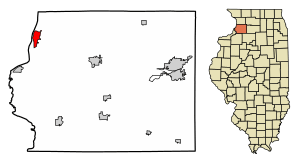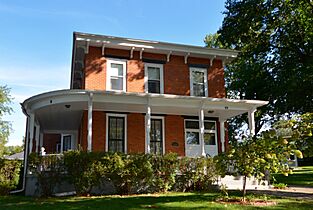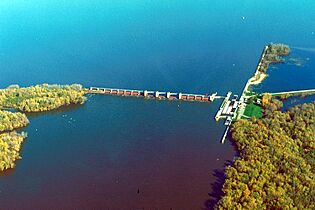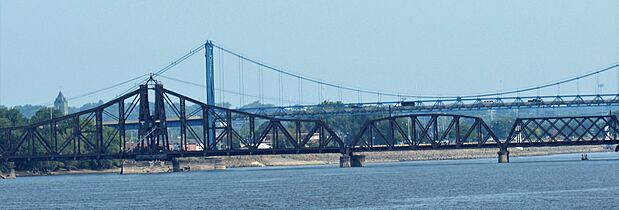Fulton, Illinois facts for kids
Quick facts for kids
Fulton, Illinois
|
||
|---|---|---|

|
||
|
||

Location of Fulton in Whiteside County, Illinois.
|
||

Location of Illinois in the United States
|
||
| Country | United States | |
| State | Illinois | |
| County | Whiteside | |
| Area | ||
| • Total | 2.80 sq mi (7.25 km2) | |
| • Land | 2.34 sq mi (6.05 km2) | |
| • Water | 0.46 sq mi (1.19 km2) | |
| Population
(2020)
|
||
| • Total | 3,647 | |
| • Density | 1,559.88/sq mi (602.37/km2) | |
| Time zone | UTC-6 (CST) | |
| • Summer (DST) | UTC-5 (CDT) | |
| ZIP Code(s) |
61252
|
|
| Area code(s) | 815 | |
| FIPS code | 17-28144 | |
| Wikimedia Commons | Fulton, Illinois | |
Fulton is a city in Whiteside County, Illinois, United States. It's located right across the Mississippi River from Clinton, Iowa. In 2020, about 3,647 people lived here. Fulton is known for its strong Dutch heritage and a famous windmill!
Contents
History of Fulton
Fulton got its name from Robert Fulton, who invented the steamboat. A post office has been operating in the city since 1838.
Exploring Fulton's Geography
Fulton is located on the east bank of the Mississippi River, near Lock and Dam #13. This area is known for its beautiful river views.
The city covers about 2.80 square miles (7.25 square kilometers). Most of this area is land, with a small part being water.
Dutch Heritage and Local Attractions
Fulton is very proud of its Dutch heritage. This is clear when you see the traditional Dutch windmill, De Immigrant. It stands near the city's dike, which is a wall that protects the land from the Mississippi River.
Other fun places to visit in Fulton include:
- The Martin House Museum
- Heritage Canyon
- The Dutch Days festival, which happens every year on the first weekend of May.
- The amazing views of the Mississippi River.
Fulton's Climate Overview
| Climate data for Fulton, Illinois (1991–2020 normals, extremes 1938–present) | |||||||||||||
|---|---|---|---|---|---|---|---|---|---|---|---|---|---|
| Month | Jan | Feb | Mar | Apr | May | Jun | Jul | Aug | Sep | Oct | Nov | Dec | Year |
| Record high °F (°C) | 62 (17) |
72 (22) |
83 (28) |
91 (33) |
96 (36) |
98 (37) |
102 (39) |
102 (39) |
96 (36) |
90 (32) |
82 (28) |
68 (20) |
102 (39) |
| Mean daily maximum °F (°C) | 29.3 (−1.5) |
33.8 (1.0) |
45.7 (7.6) |
59.4 (15.2) |
71.1 (21.7) |
80.7 (27.1) |
84.0 (28.9) |
82.1 (27.8) |
75.9 (24.4) |
63.0 (17.2) |
47.6 (8.7) |
34.8 (1.6) |
58.9 (14.9) |
| Daily mean °F (°C) | 21.4 (−5.9) |
25.4 (−3.7) |
36.9 (2.7) |
49.6 (9.8) |
61.2 (16.2) |
71.2 (21.8) |
74.6 (23.7) |
72.7 (22.6) |
65.5 (18.6) |
53.2 (11.8) |
39.5 (4.2) |
27.7 (−2.4) |
49.9 (9.9) |
| Mean daily minimum °F (°C) | 13.6 (−10.2) |
17.1 (−8.3) |
28.2 (−2.1) |
39.8 (4.3) |
51.4 (10.8) |
61.7 (16.5) |
65.2 (18.4) |
63.2 (17.3) |
55.2 (12.9) |
43.4 (6.3) |
31.4 (−0.3) |
20.5 (−6.4) |
40.9 (4.9) |
| Record low °F (°C) | −33 (−36) |
−27 (−33) |
−14 (−26) |
13 (−11) |
30 (−1) |
40 (4) |
46 (8) |
40 (4) |
26 (−3) |
13 (−11) |
−5 (−21) |
−22 (−30) |
−33 (−36) |
| Average precipitation inches (mm) | 1.40 (36) |
1.56 (40) |
2.41 (61) |
3.39 (86) |
4.03 (102) |
4.52 (115) |
3.40 (86) |
3.43 (87) |
3.66 (93) |
2.58 (66) |
2.20 (56) |
1.69 (43) |
34.27 (870) |
| Average precipitation days (≥ 0.01 in) | 6.5 | 6.3 | 8.1 | 9.9 | 10.8 | 10.5 | 7.8 | 8.2 | 7.5 | 8.0 | 6.8 | 7.4 | 97.8 |
| Source: NOAA | |||||||||||||
Fulton's Population and Community
| Historical population | |||
|---|---|---|---|
| Census | Pop. | %± | |
| 1860 | 1,512 | — | |
| 1870 | 1,875 | 24.0% | |
| 1880 | 1,733 | −7.6% | |
| 1890 | 2,099 | 21.1% | |
| 1900 | 2,685 | 27.9% | |
| 1910 | 2,174 | −19.0% | |
| 1920 | 2,445 | 12.5% | |
| 1930 | 2,656 | 8.6% | |
| 1940 | 2,585 | −2.7% | |
| 1950 | 2,706 | 4.7% | |
| 1960 | 3,387 | 25.2% | |
| 1970 | 3,630 | 7.2% | |
| 1980 | 3,936 | 8.4% | |
| 1990 | 3,698 | −6.0% | |
| 2000 | 3,881 | 4.9% | |
| 2010 | 3,481 | −10.3% | |
| 2020 | 3,647 | 4.8% | |
| U.S. Decennial Census | |||
In 2020, about 3,647 people lived in Fulton. The city has grown and changed over many years. The median age in 2000 was 40 years old.
Education in Fulton
Students in Fulton attend schools within the River Bend Community Unit District 2.
Notable People from Fulton
Fulton has been home to some interesting people, including:
- John R. Huizenga – A professor of chemistry and physics who helped with the Manhattan Project and discovered new elements.
- Jack Reagan – The father of former U.S. President Ronald Reagan.
- Nelle Wilson Reagan – The mother of Ronald Reagan.
- Paul Rhymer – The creator and writer of the radio show Vic and Sade. He was born in Fulton.
Gallery
-
Martin House at 707 10th Avenue
-
Aerial view of Lock and Dam No. 13, located on the Mississippi River, Clinton, Iowa.
See also
 In Spanish: Fulton (Illinois) para niños
In Spanish: Fulton (Illinois) para niños






